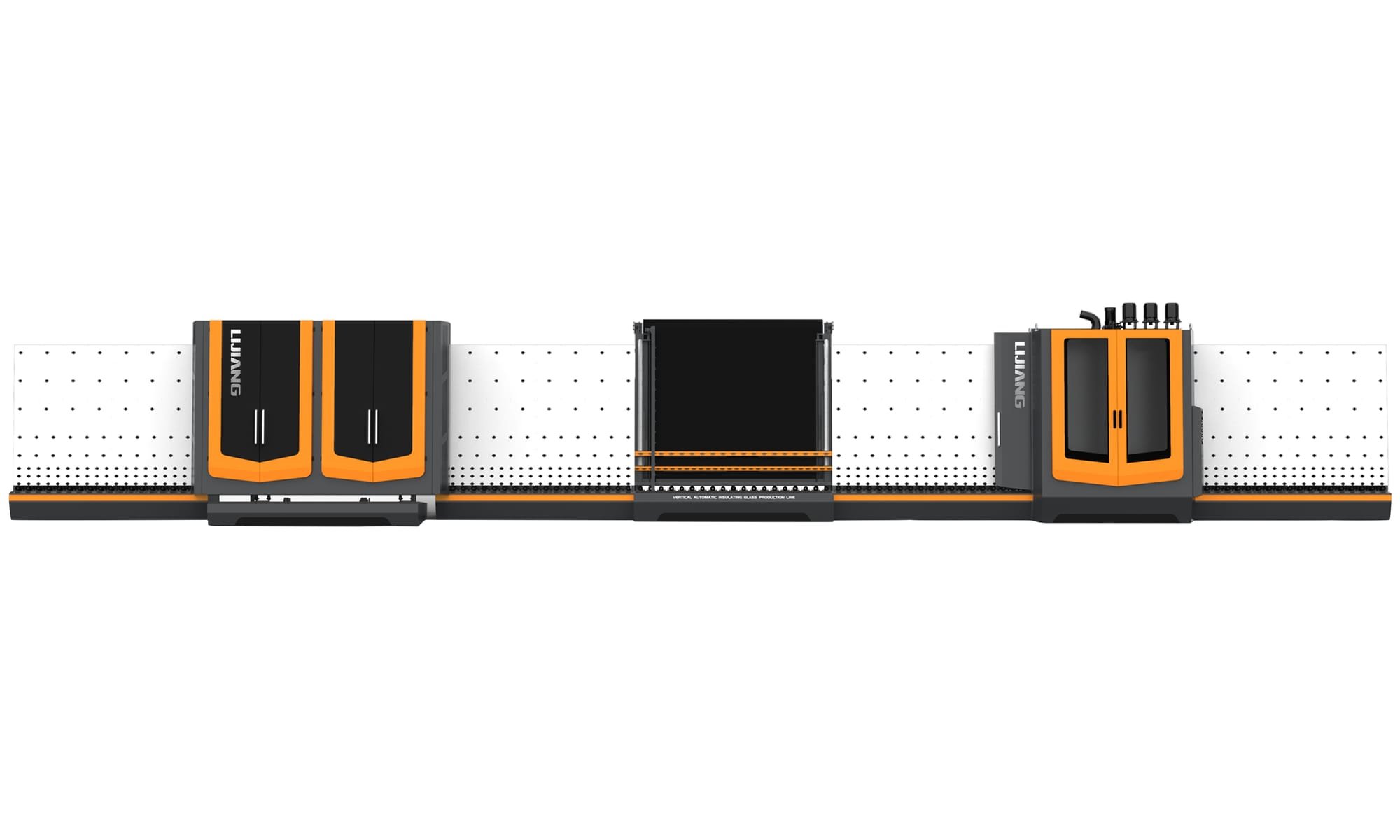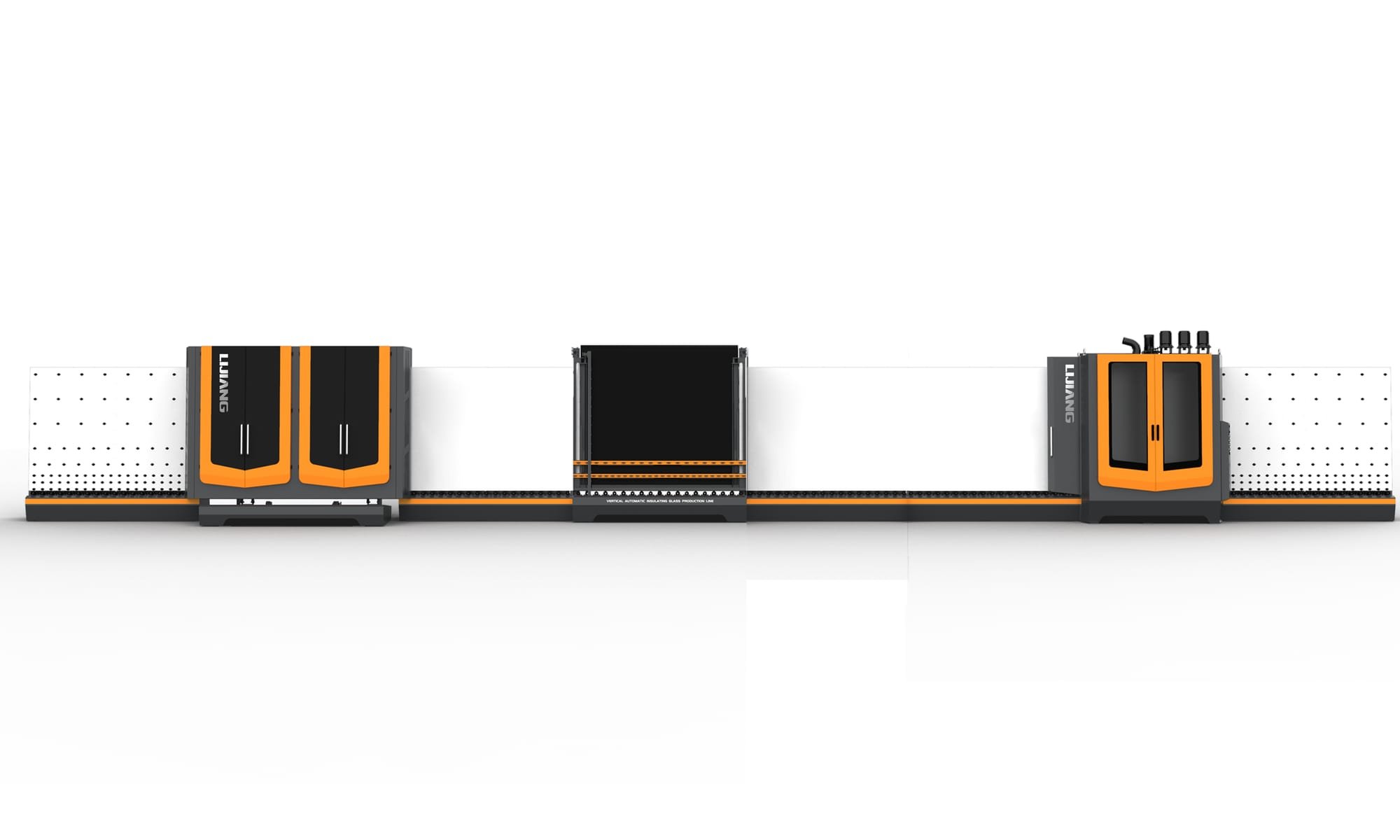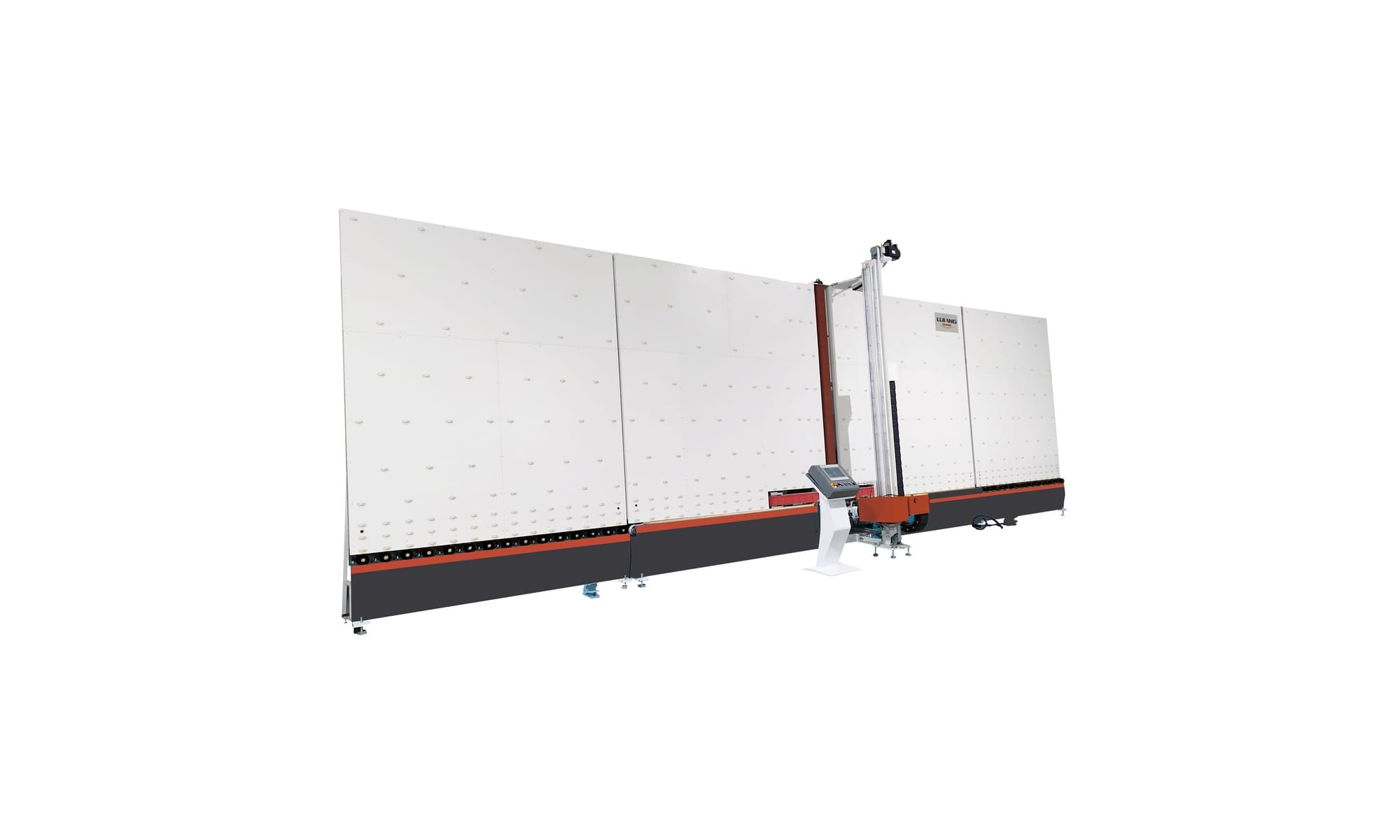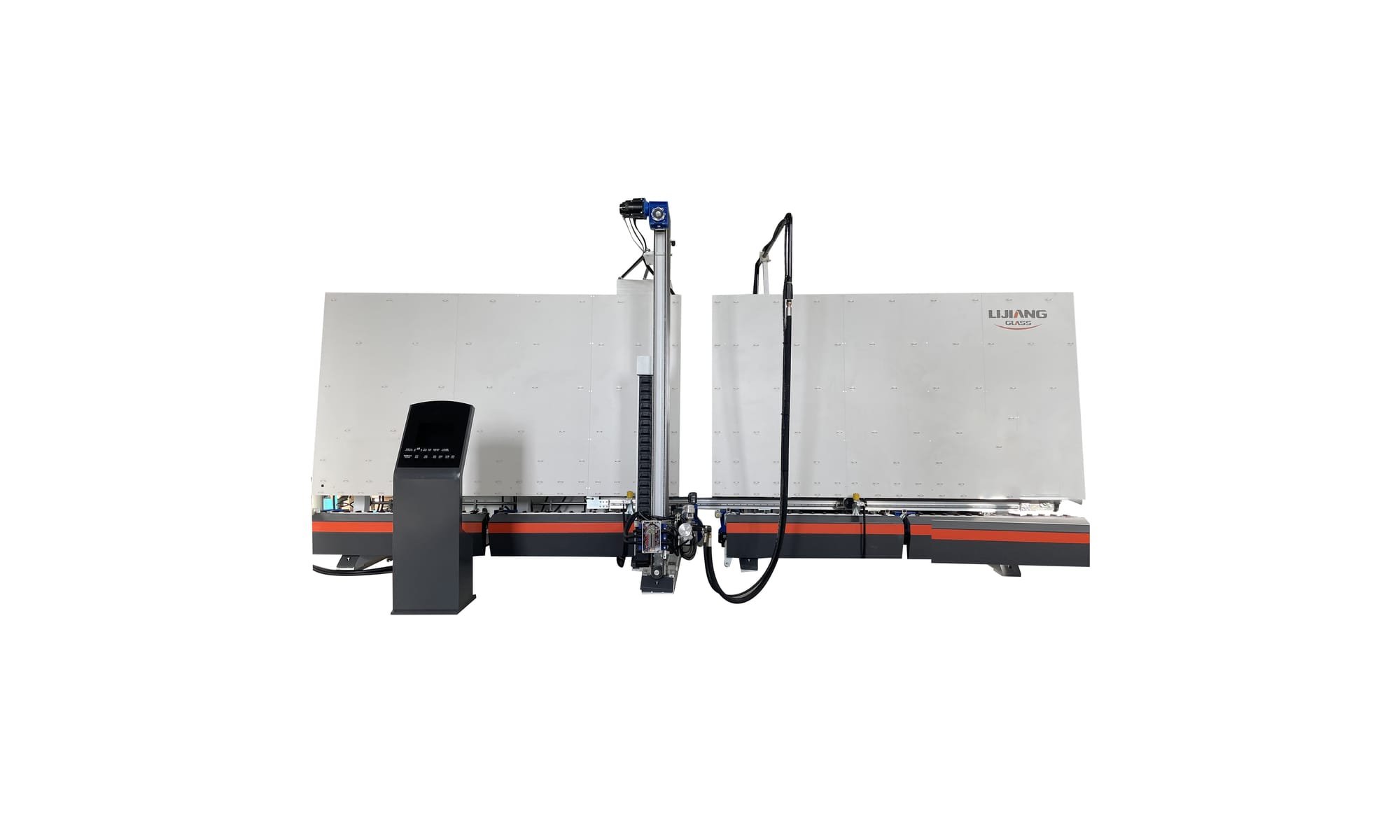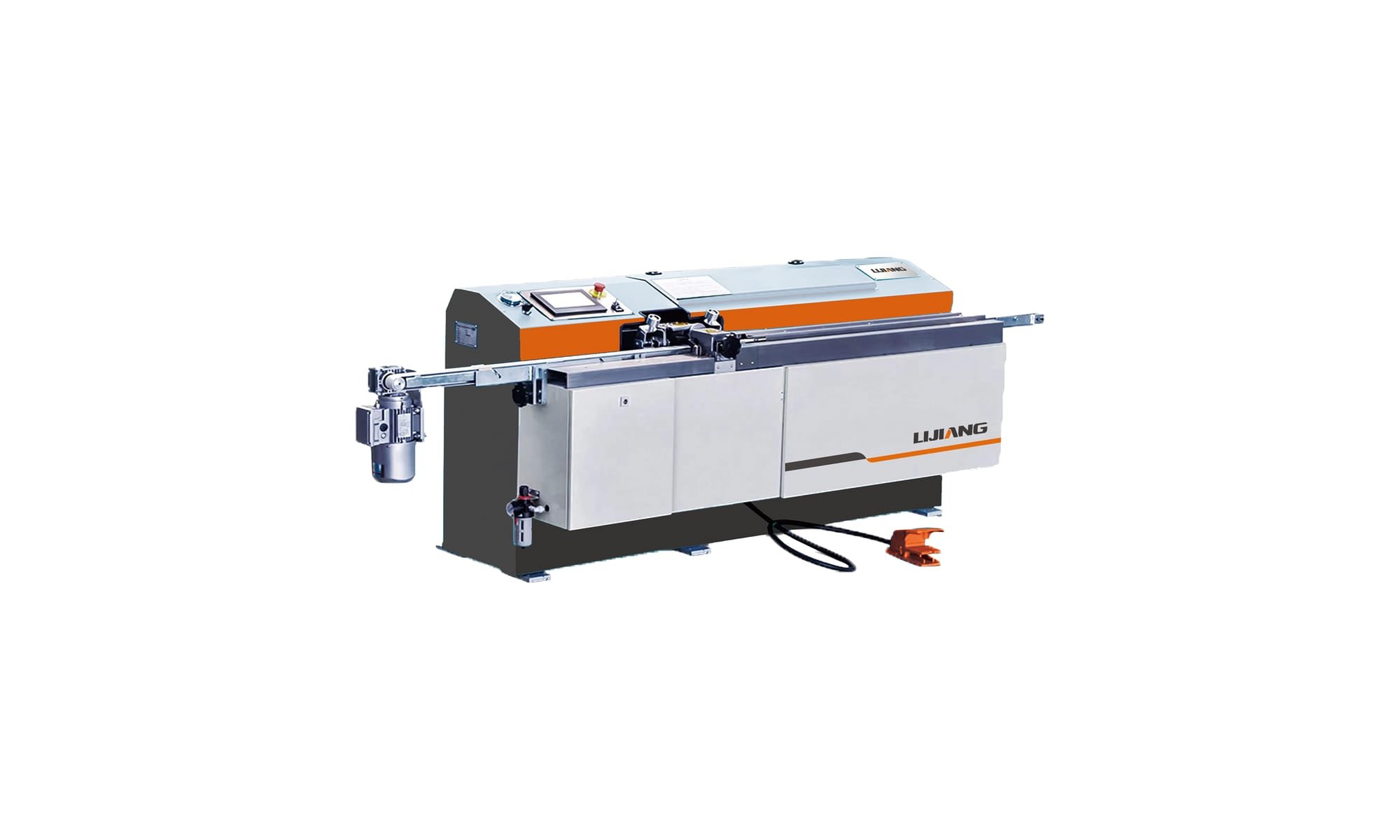Automatische Isolierglasausrüstung
Wenn Sie auf dem heutigen Markt eine neue Isolierglasbearbeitungsmaschine kaufen, finden Sie überall ähnliche Produkte. Egal, ob Sie ein Anfänger oder ein Experte sind, es ist schwierig, die beste Lösung für Ihr Unternehmen auszuwählen. Sie müssen ähnliche Funktionen und Kosten vergleichen, sich nach dem besten Preis umsehen und wissen, wie Sie mit der Transaktion umgehen. Hier sind vier einfach zu befolgende Schritte, die ein Käufer unternehmen würde, um eine neue Isolierglasbearbeitungsmaschine zu kaufen.
Grundlegendes Arbeitsprinzip
- Deutschland Siemens SPS-Steuerungssystem, Touchscreen-Schnittstelle für Fingerberührung
- Automatische Erkennung von beschichtetem Glas und Low-E-Glas;
- 3 Paar weiche Bürsten können Online-Low-E-Glas und Offline-Low-E-Glas waschen;
- Die waschenden Teile nehmen SS-Material und wasserdichtes Gerät an;
- Wassertank mit automatischer Temperaturregelung und Wasserwaschsystem.
- Luftheizung;
- Automatische Start- und Stoppeinstellung des Luftgebläses;
- Rauschunterdrückungssystem;
- Online-Anzeige der Waschgeschwindigkeit;
- Intelligente intermittierende Arbeit, Energie sparen;
- Verstellbares Pressbrett, um die Plattenpressfläche gerade zu halten;
- Verbindungsmodus des Luftfahrtsteckers;
- Anwendbar zur Herstellung von Dreifach-MIG und geformten MIG.
Detaillierte Arbeitsschritte
- Vorwaschfunktion;
- Automatisch genaue Positionierung für DGUs mit 3 oder 4 Seitenschritten;
- Die automatische Argongasfüllung könnte den Gaswert einstellen und den Füllprozess mit hoher Gaskonzentration online anzeigen.
Technische Parameter
| Unit | LJBZ2030 | LJBZ2030G | LJBZ2535 | LJBZ2535G | LJBZ2535DG | |
| Voltage | 380V 50Hz 3P | |||||
| Total Power | Kw | 39.5 | 36 | 41 | 39.5 | 44 |
| Washing Speed | m/min | 2-10 | ||||
| Maximum Working Speed | m/min | 45 | ||||
| Minimum Glass Size | mm | 450*280 | ||||
| Maximum Glass Size | mm | 2000*3000 2000*3500 (Secondary Tableting) | 2500*3500 2500*4000(Secondary Tableting) 2500*4500(Secondary tablet pressing and auxiliary suction cup mechanism) | |||
| Flat Glass Thickness | mm | 3~15(Could be customized 3~30) | ||||
| Washing Brushes | pieces | 6 | ||||
| Maximum Thickness of Insulating Glass | mm | 60 | ||||
| Total Gas Consumption | L/min | 1200 | ||||
| Conveyer roll Height | mm | 520 | ||||
| Dimension L*W*H | mm | 20200*3500*3200 | 23800*3500*3700 | 27200*3500*3700 | ||
Technische Beschreibung

Grundlegendes Arbeitsprinzip
- Air-floating back plate, to avoid the wheel scraching the glass and leaving wheel marks;
- Two pieces of IGUs or DGUs could be pressed and filled gas in once time, high work efficiency;
- Argon-gas filling in pressing, automatic filling the glass in different areas according to the size of glass;
- Germany Siemens PLC control system, touch screen interface for finger touch operating;
- Automatic identification of coated glass and Low-E glass;
- 3 pairs of soft brushes could wash online Low-E glass and offline Low-E glass;
- The washing parts adopt SS material and waterproof device;
- Water tank with automatic temperature control and water washing system;
- Air heating system;
- Air Fan automatic start and stop setting;
- Noise reduction system;
- Online display of washing speed;
- Intelligent intermittent work, saving-energy;
- Adjustable external rotary positioning system of DGUs or IGUs;
- Connection mode of aviation plug;
- ERP system is optional.
Detaillierte Arbeitsschritte
Zusätzlich zu den technischen Merkmalen der gewöhnlichen Produktionslinie und der aufblasbaren Produktionslinie verfügt die vollautomatische Isolierglas-Produktionslinie der Serie LJBZ2030GF/LJBZ2535GF über eine Luftflotationsfunktion im Übertragungsbereich zwischen dem Waschbereich und dem Plattenpressbereich, wodurch das Glas hergestellt wird Oberfläche während des Inspektionsprozesses nahtlos. Kein menschlicher Kontakt und keine Verdeckung von Geräteteilen. Die Standardspezifikationen sind 2000 mm x 2800 mm und 1500 mm x 2200 mm.
Technische Parameter
| Unit | LJBZ2030GF | LJBZ2535GF | LJBZ2535DGF | |
| Voltage | 380V 50Hz 3P | |||
| Total Power | Kw | 41 | 44.5 | 58 |
| Washing Speed | m/min | 2~10 | ||
| Maximum Working Spped | m/min | 45 | ||
| Minimum Glass Size | mm | 450*280 | ||
| Maximum Glass Size | mm | 2000*3000 2000*3500(Secondary tableting) | 2500*3500 2500*4000(Secondary tableting) 2500*5000 (Secondary tablet pressing and auxiliary suction cup mechanism) | |
| Flat Glass Thickness | mm | 3·15(can be customized 3~30) | ||
| Washing Brushes | pieces | 6 | ||
| Maximum Thickness of insulated glass | mm | 60 | ||
| Total Gas Consumption | L/min | 1200 | ||
| Conveyer Roll Height | mm | 520 | ||
| Dimension L*W*H | mm | 20200*3500*3200 | 23800*3500*3700 | 27200*3500*3700 |
Technische Beschreibung

Automatisches Doppelplattenpressen in Jumbo-Größe mit Argongas-Füllung für Isolierglas-Produktionslinie
LIJIANG Glas - Typ: LJBZ3370
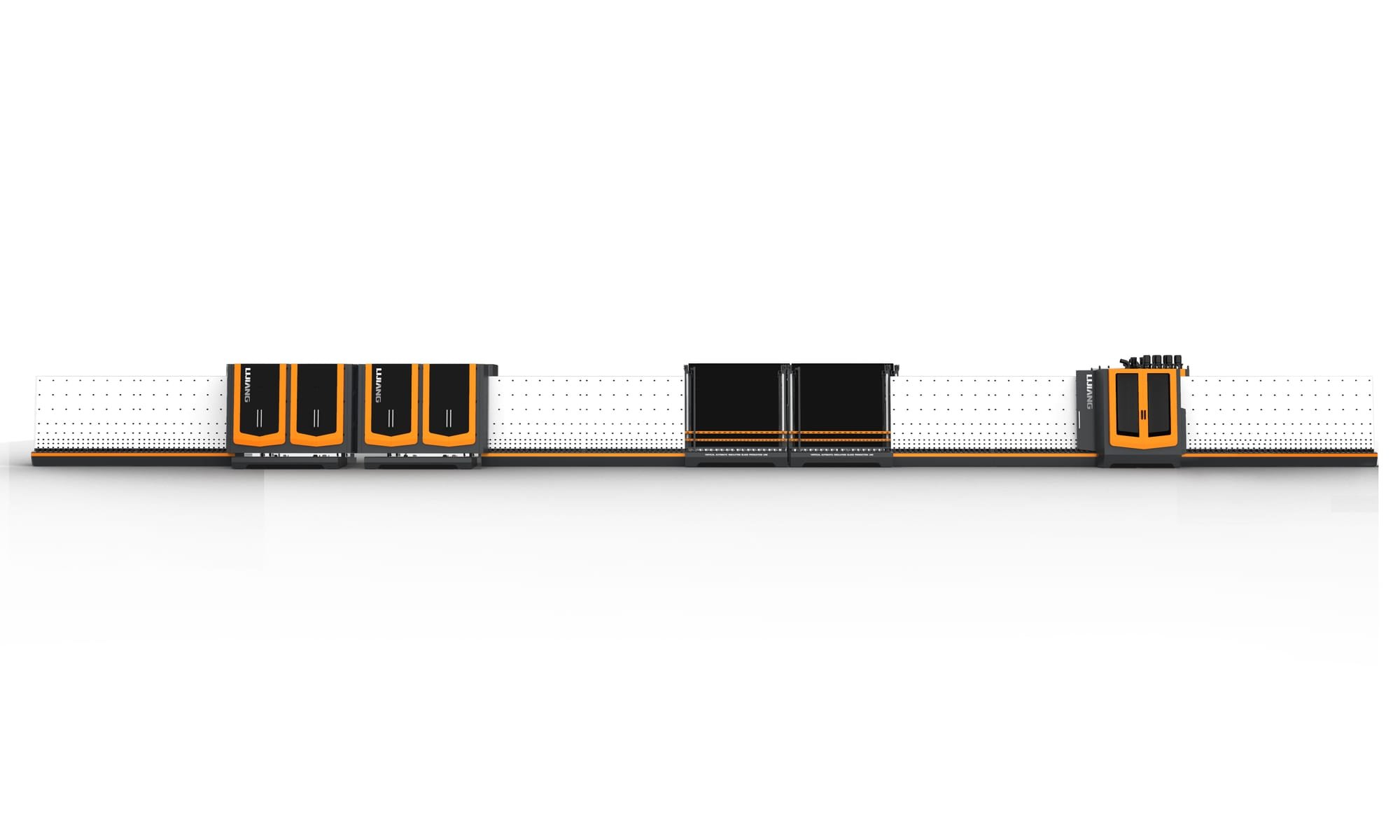
Grundlegendes Arbeitsprinzip
Regular Function
Optional Function
- Germany SIemens PLC control system, touch screen interface to finger touch operating;
- Automatic identification of coated glass and Low-E glass;
- 3 pairs of soft brushes could wash online Low-E glass and offline Low-E glass;
- Water tank with automatic temperature control and water washing system;
- Air heating system;
- Air Fan automatic start and stop setting;
- Noise reduction system;
- Online display of washing speed;
- Intelligent intermittent work, saving-energy;
- Adjustable pressing board to keep the plate pressing surface straight;
- Connection mode of aviation plug
- Applicable to produce triple IGUs and shaped IGUs.
Optional Function
- Pre-washing Function;
- Automatically accurate positioning for 3 side step DGUs or 4 side step IGUs;
- Automatic argon-gas filling could set gas value and display the process of filing online with high gas concentration.
Detaillierte Arbeitsschritte
The comparison of two design structures of large-panel insulated glass production lines
For example, the maximum size of insulating glass required for a construction project is 3m*6m.
① The equipment structure:
Extended size equipment + Inside combination technology + Two plate-pressing sections + Online argon-gas filling function
Each section of the production line needs to be designed and extended to the maximum size of the large-panel insulating glass, and the equipment size of all processing sections except the vertical glass washing and drying machine is upgraded to more than 6m. At the same time, the plate pressing section is made into two sections, and the processing method of combining the plates inside the plate is adapted to meet the requirement that the maximum length reaches 6m.
Advantage:
1. It can realize the one-time plate press molding of large plate insulating glass, and complete the argon filling function at one time, without the need for multiple processing operations;
2. It can realize simultaneous pressing and inflating of two pieces of insulating glass to improve production efficiency.
Disadvantages:
1. The production line occupies a large workshop area;
2. The price is relatively high.
Know More
②The equipment structure:
Normal size equipment + Outside combination technology + Only one plate-pressing sections + Offline argon-gas filling function
It using the method of outside combination sheet + single plate press, it is necessary to combine two pieces of 3m*6m glass together outside the plate press, and the glass enters the plate press two or more times Pressing for the second time, and then manually inflating to complete the processing of insulating glass.
Advantage:
1. The equipment of the second structure is about 4 meters shorter than the double-plate press of the first structure, and the floor space is smaller.
2. The price is relatively lower than LIJIANG Glass LJBZ3370 Automatic Jumbo Size Insulating Glass Production Line.
Disadvantages:
1. The length of the plate press is not enough, it needs to be pressed twice or more times, which will cause uneven pressing of the first sealant butyl rubber coating and affect the sealing effect of the glass.
2. There is no way to fill the glass with argon gas online. The only way is to move the glass offline to punch holes and then manually inflate the gas. Manual inflation takes a long time, and it is difficult to meet the standard requirements of a gas content.
3. During the processing of large glass plates, multiple pressings are required, and the production efficiency will also be reduced.
For example, the maximum size of insulating glass required for a construction project is 3m*6m.
① The equipment structure:
Extended size equipment + Inside combination technology + Two plate-pressing sections + Online argon-gas filling function
Each section of the production line needs to be designed and extended to the maximum size of the large-panel insulating glass, and the equipment size of all processing sections except the vertical glass washing and drying machine is upgraded to more than 6m. At the same time, the plate pressing section is made into two sections, and the processing method of combining the plates inside the plate is adapted to meet the requirement that the maximum length reaches 6m.
Advantage:
1. It can realize the one-time plate press molding of large plate insulating glass, and complete the argon filling function at one time, without the need for multiple processing operations;
2. It can realize simultaneous pressing and inflating of two pieces of insulating glass to improve production efficiency.
Disadvantages:
1. The production line occupies a large workshop area;
2. The price is relatively high.
Know More
②The equipment structure:
Normal size equipment + Outside combination technology + Only one plate-pressing sections + Offline argon-gas filling function
It using the method of outside combination sheet + single plate press, it is necessary to combine two pieces of 3m*6m glass together outside the plate press, and the glass enters the plate press two or more times Pressing for the second time, and then manually inflating to complete the processing of insulating glass.
Advantage:
1. The equipment of the second structure is about 4 meters shorter than the double-plate press of the first structure, and the floor space is smaller.
2. The price is relatively lower than LIJIANG Glass LJBZ3370 Automatic Jumbo Size Insulating Glass Production Line.
Disadvantages:
1. The length of the plate press is not enough, it needs to be pressed twice or more times, which will cause uneven pressing of the first sealant butyl rubber coating and affect the sealing effect of the glass.
2. There is no way to fill the glass with argon gas online. The only way is to move the glass offline to punch holes and then manually inflate the gas. Manual inflation takes a long time, and it is difficult to meet the standard requirements of a gas content.
3. During the processing of large glass plates, multiple pressings are required, and the production efficiency will also be reduced.
Technische Parameter
| Unit | LJBZ3370 | |
| Voltage | 380V 50Hz 3P | |
| Total Power | Kw | 54.5 |
| Washing Speed | m/min | 2~10 |
| Maximum Working Speed | m/min | 45 |
| Minimum Glass Size | mm | 450*280 |
| Maximum Glass Size | mm | 3300*7000(Single-Press Mode) 3000*3000(Double-Press Mode) |
| Flat Glass Thickness | mm | 3~30 |
| Washing Brushes | pieces | 6 |
| Maximum Thickness of Insulated Glass | mm | 80 |
| Total Gas Consumption | L/min | 1500 |
| Conveyer Roll Height | mm | 520 |
| Dimensions(L*W*H) | mm | 47200*3500*4500 |
Technische Beschreibung

Grundlegendes Arbeitsprinzip
- Sechs Sätze Servomotoren, britisches TRIO-System;
- Einlass-Auslass mit zwei Richtungen, 4 Richtungen sind verfügbar;
- Glasgröße automatisch messen;
- Low-E-Glasbeschichtung automatisch unterscheiden;
- Die Breite der Low-E-Glaskantenlöschung ist einstellbar;
- Nimmt PLC-Steuerungssystem, Touchscreen-Schnittstelle für Finger-Touch-Bedienung an;
- Intelligentes Kontrollsystem, könnte Stapelverarbeitung erkennen.
Detaillierte Arbeitsschritte
- Löschen von geformtem Low-E-Glas;
- Automatische Erkennung von Low-E-Glasfolien.
Technische Parameter
| Item. | Spec. |
| Voltage | 380V 50Hz 3P |
| Max. Glass Processing Size | 2500 mm*4500 mm |
| Min. Glass Processing Size | 300 mm*400 mm |
| Glass Thickness | 3-15 mm |
| Low-E Edge Deleting Width | 10-500 mm |
| Glass Conveying Speed | 0-30 m/min |
| Low-E Glass Edge Deleting Speed | 2-29 m/min |
| Grinding Wheel Width | 10/12/15 mm |
| Total Power | 15 Kw |
| Dimension(L*W*H) | 9700*2500*3400 mm |
| Weight | 2600 Kg |
Technische Beschreibung

Grundlegendes Arbeitsprinzip
- Nimmt Japan Yaskawa Servosteuerungssystem an, vollautomatisch und hocheffizient;
- Automatische Speicherfunktion, keine wiederholte Eingabe von Parametern erforderlich;
- Reparieren Sie Glasecken automatisch mit Schaber und Rolle;
- Der Förderabschnitt der Ausrüstung könnte in vier Abschnitte unterteilt werden, und Glas kann vorgelagert werden;
- Glasgröße und Glastiefe automatisch messen, Versiegelungsgeschwindigkeit anpassen;
- Zahnriemen, reibungslose Übertragung und genaue Position annehmen;
- Alle Automatikfunktionen sind manuell bedienbar;
- Könnte die Doppelverglasung, das geformte Glas, das Stufenglas, das Dreifachglas beschichten.
- Ein Satz Druckerhöhungspumpe steuert zwei Gruppen von Dichtungsmitteln;
- Automatische Timing-Dichtungsmittel-Entladefunktion;
- Das Dichtungsmittel-Mischsystem hat eine Anti-Blockier-Struktur und ist leicht zu reinigen.
Detaillierte Arbeitsschritte
Equipment preparation: a. Make sure the power connection of the sealing line is normal, and confirm that the required air source and glue supply system are working properly. b. Check whether all components and sensors of the sealing line are intact, and perform necessary maintenance and cleaning.
Set parameters: a. On the control interface of the sealing line, set relevant parameters, such as glass plate size, sealing speed, sealing width, sealing thickness, etc. Set parameters according to product requirements and process specifications. b. If using two-component glue, you need to set the glue ratio and mixing time.
Start the sealing robot equipment: a. Press the start button to start the sealing robot equipment. Ensure the safety of the insulating glass production line and wait for the sealing robot equipment to enter normal working conditions.
Automatic conveying of glass plates: a. Place the glass plate to be sealed on the conveyor belt or transmission mechanism to ensure that the position and positioning of the glass plate are accurate.
Automatic sealant sealing application: a. The sealing line will automatically apply sealant evenly to the edge of the glass plate or the parts that need to be sealed according to the set parameters. Ensure that the sealing robot equipment works stably and the glue is sprayed evenly.
Glass plate fixing: a. After the sealant is sprayed, the sealing line will fix another glass plate to be sealed on the glass plate that has been coated with sealant. Make sure the glass panels are aligned accurately and sealed tightly.
Sealant sealing and compression: a. The insulating glass sealing robot machine will perform a certain pressure treatment on the two glass plates to ensure a tight combination of the sealant and the glass plates. Set appropriate pressure and duration based on product requirements and equipment capabilities.
Set parameters: a. On the control interface of the sealing line, set relevant parameters, such as glass plate size, sealing speed, sealing width, sealing thickness, etc. Set parameters according to product requirements and process specifications. b. If using two-component glue, you need to set the glue ratio and mixing time.
Start the sealing robot equipment: a. Press the start button to start the sealing robot equipment. Ensure the safety of the insulating glass production line and wait for the sealing robot equipment to enter normal working conditions.
Automatic conveying of glass plates: a. Place the glass plate to be sealed on the conveyor belt or transmission mechanism to ensure that the position and positioning of the glass plate are accurate.
Automatic sealant sealing application: a. The sealing line will automatically apply sealant evenly to the edge of the glass plate or the parts that need to be sealed according to the set parameters. Ensure that the sealing robot equipment works stably and the glue is sprayed evenly.
Glass plate fixing: a. After the sealant is sprayed, the sealing line will fix another glass plate to be sealed on the glass plate that has been coated with sealant. Make sure the glass panels are aligned accurately and sealed tightly.
Sealant sealing and compression: a. The insulating glass sealing robot machine will perform a certain pressure treatment on the two glass plates to ensure a tight combination of the sealant and the glass plates. Set appropriate pressure and duration based on product requirements and equipment capabilities.
Technische Parameter
| Item. | Spec. |
| Max. Glass Size | 2000*3000 mm/2500*4000 mm/3300*7000 mm |
| Min. Glass Size | 400*300 mm |
| Glass Thickness | 12-56 mm/12-56 mm/12-80 mm |
| Working Speed | 5-40 mm |
| Air Pressure | 0.6-0.8 MPa |
| Squeeze Pressure | <35 MPa |
| Voltage | 380V 50Hz 3P |
| Power | 15 Kw/15 Kw/20 Kw |
| Overall Dimension(L*W*H) | 3700*2500*3000 mm/8700*2500*3500 mm/ 15000*2500*4300 mm |
| Weight | 4300 kg/5000 kg/7000 kg |
Technische Beschreibung
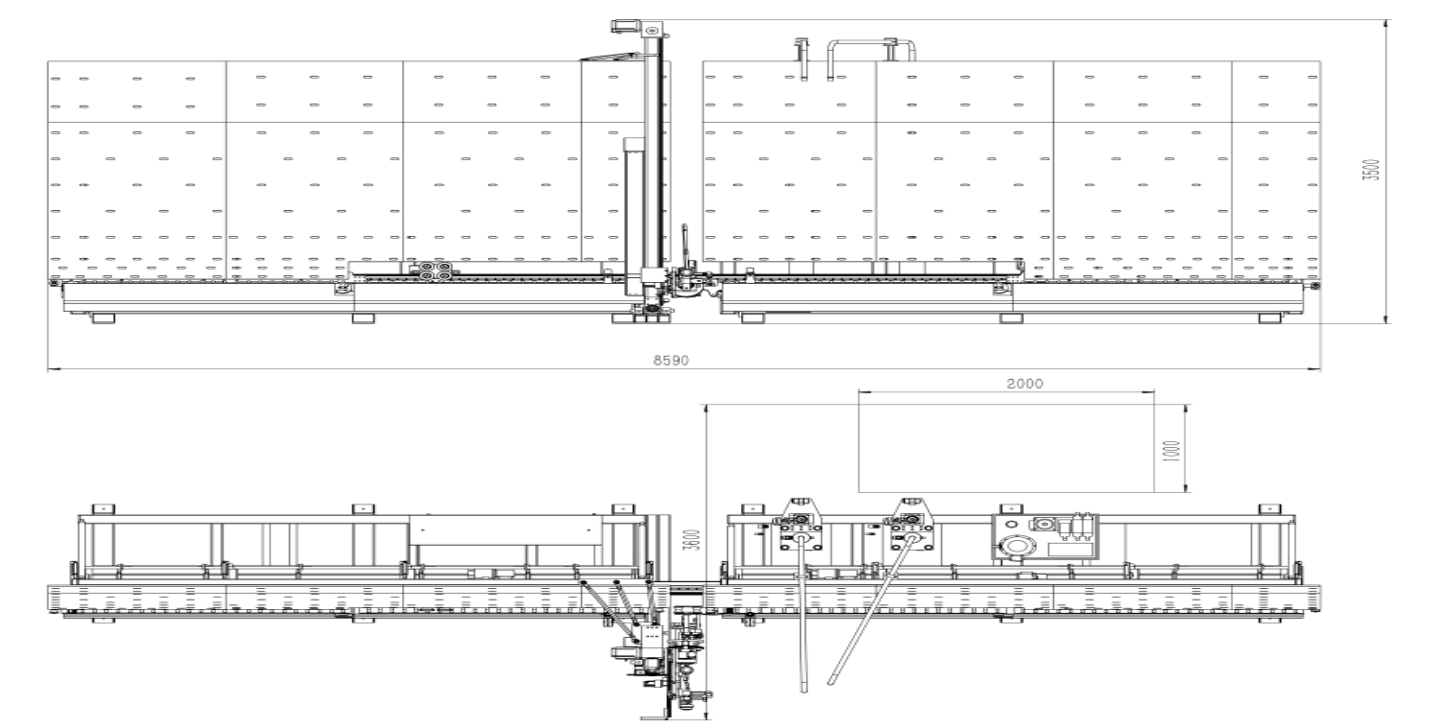 LJTJ2030/LJTJ2540 Automatische Isolierglas-Versiegelungsroboterausrüstung 2
LJTJ2030/LJTJ2540 Automatische Isolierglas-Versiegelungsroboterausrüstung 2 Automatische Isolierglas-Aluminium-Abstandshalter-Biegemaschine
LIJIANG Glas - Typ: LJZW2020 / LJZW2020N
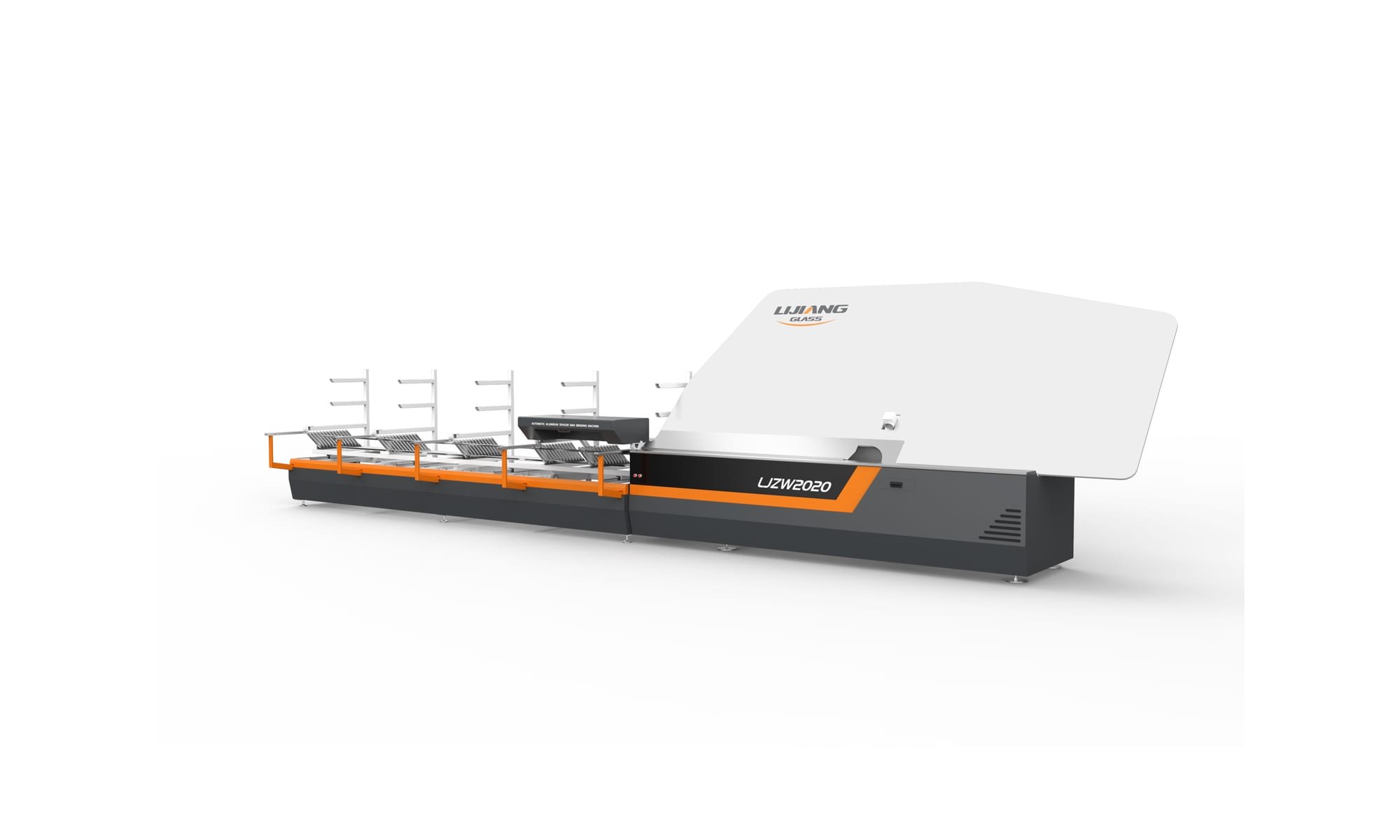
Grundlegendes Arbeitsprinzip
General Performance
Optional Performance
- Adopts the servo control feeding system, the size of aluminum spacers could be adjusted with an accuracy of 0.1 mm/m;
- CNC Bending angle control system with adjustable accuracy of 0.1°;
- Sets up four groups of aluminum spacers and stainless steel spacers storage units;
- Aluminum spacer bars with multiple sizes could be selected at will;
- Automatically adjust the bending speed according to the size of the aluminum spacer or stainless steel spacer to avoid the deformation of the large spacer and ensure the high speed and continuity of the small frame;
- Automatic continuous connection of spacer, cutting spacer, avoidance of spacer joint;
- No material prompt, sleep prompt, fault prompt, work prompt, unreasonable data refuse processing and prompt support arc-shaped aluminum spacer and special shaped aluminum spacer bending;
- USB function, which could read EXCEL directly;
Optional Performance
- Could connect with ERP system;
- Could optional the function of automatic printing code, automatic printing label, bending the stainless steel spacer, bending the warm edge spacer, bending the stainless steel composite warm edge strips, bending the glass fiber warm edge strips, and bending the pure opaque steel strips.
Detaillierte Arbeitsschritte
Bedienschritte
- Schalten Sie den Strom ein, schalten Sie den Betriebsschalter an der Steuerkonsole ein und drücken Sie zum Starten die Ölpumpe.
- Passen Sie den Hub an. Achten Sie darauf, den Hub vor dem Gebrauch anzupassen; und beim Auf- und Abfahren der Biegemaschine nach unten muss ein Spalt eingestellt werden. Eine Einstellung ohne Spalt führt zu einem gewissen Verschleiß an der Ausrüstung der Biegemaschine.
- Auswahl der Kerbe der Biegemaschine. Die Auswahlgrundlage ist: Die Dicke der Glasplatte beträgt etwa das 8-fache der Breite. Wenn die Dicke der Glasplatte beispielsweise 5 cm beträgt, muss die Kerbe 40 cm betragen.
- Stellen Sie den Stopper hinter der Biegemaschine manuell oder elektrisch fein ein.
- Drücken Sie den Fußpedalschalter, um das Biegen durchzuführen.
- Während der Verarbeitung müssen der Zustand und die Verarbeitungswirkung des Glases jederzeit beobachtet werden, um Geräteausfälle oder fehlerhafte Produkte zu verhindern.
- Wenn die Biegemaschine nicht mehr funktioniert, schalten Sie den Betriebsschalter am Operationstisch aus, schalten Sie dann den Strom aus und reinigen Sie die Arbeitsfläche der Biegemaschine, um die Oberfläche für den nächsten Gebrauch sauber und aufgeräumt zu machen.
Technische Parameter
| Item. | Spec. |
| Max. Bending Size | 1800*2000 mm (in once)/ 2500*4000 mm(in twice) |
| Min. Bending Size | 150*300 mm |
| Aluminum Spacer Width | 5.5-26.5 mm |
| Spacers Racks | 4 |
| Spacer Size Error | ±0.5 mm |
| Angle Error | ±1° |
| Conveying Speed | 1250 mm/s |
| Air Pressure | ≥0.65 MPa |
| Voltage | 380 50Hz 3P |
| Total Power | 2.5 Kw |
| Dimension(L*W*H) | 10500 mm*2200 mm*2600 mm |
| Weight | 1580 kg |
Technische Beschreibung
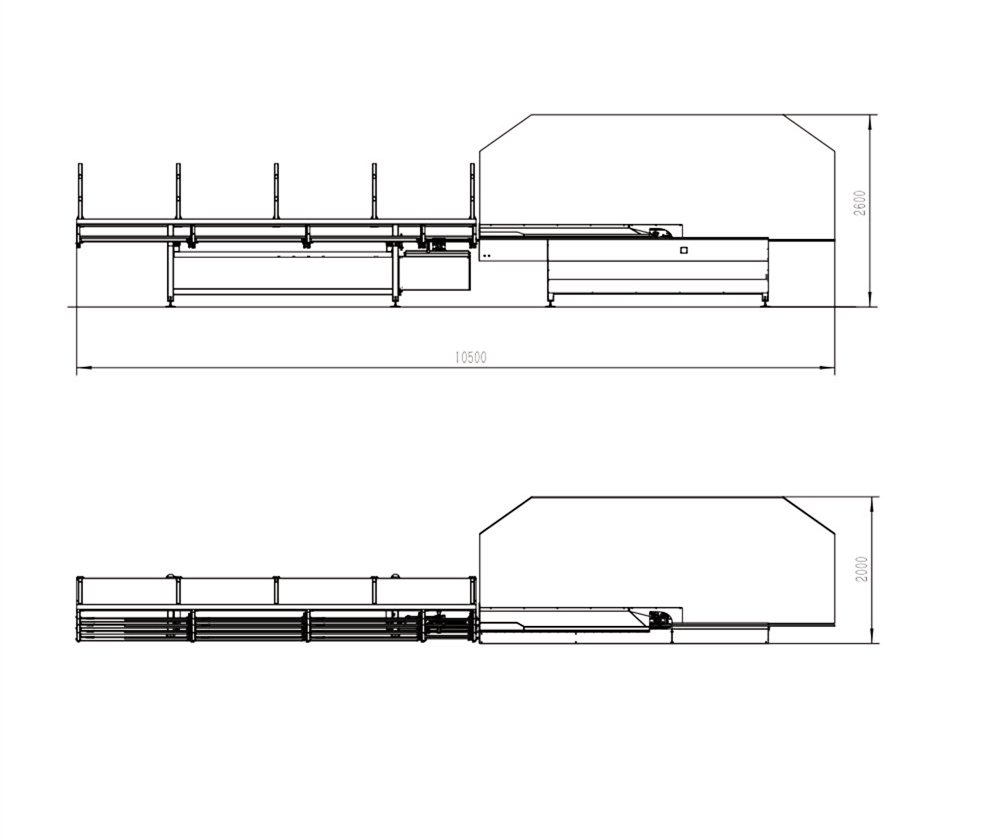 LJZW2020 Isolierglas-Aluminium-Abstandshalter-Biegemaschine
LJZW2020 Isolierglas-Aluminium-Abstandshalter-Biegemaschine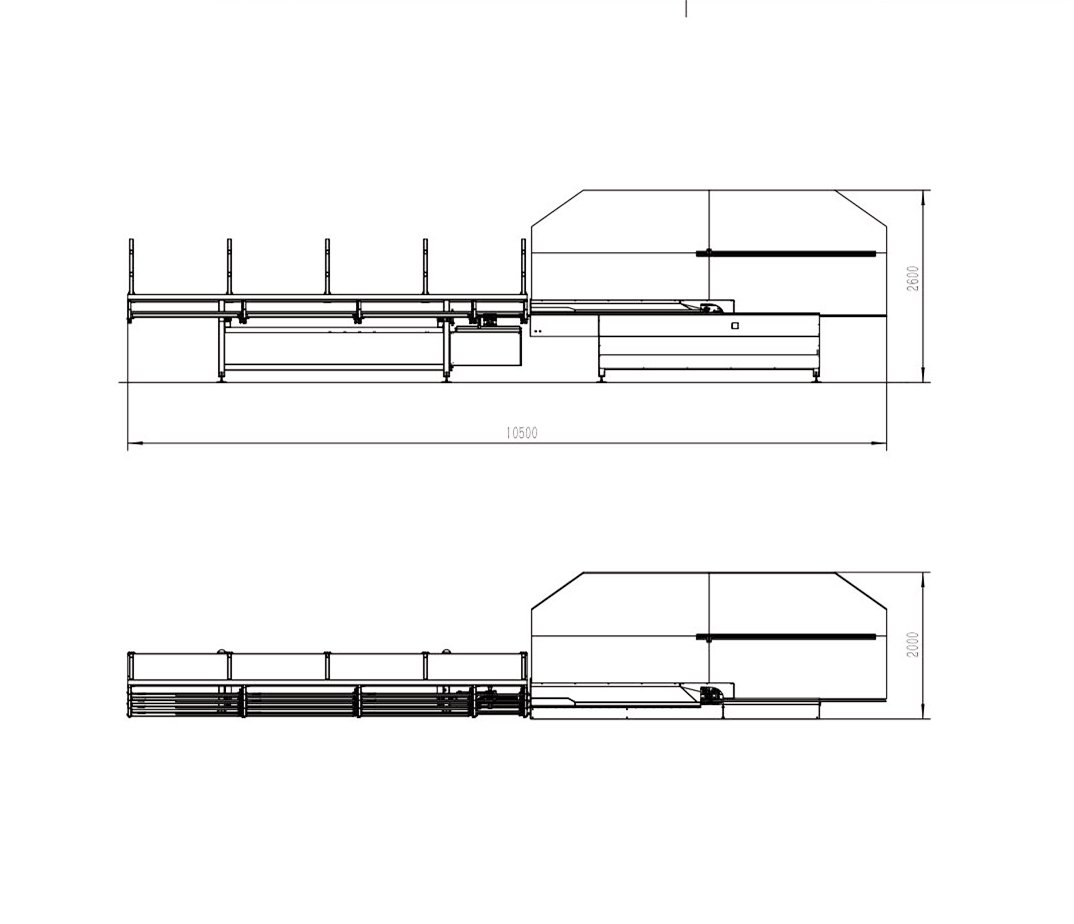 LJZW2020A Isolierglas-Aluminium-Abstandhalter-Biegemaschine
LJZW2020A Isolierglas-Aluminium-Abstandhalter-Biegemaschine Grundlegendes Arbeitsprinzip
- Die Butyl-Extrusionsgeschwindigkeit konnte 47 m/min erreichen;
- Einsparung von Butyl im Vergleich zu gewöhnlichen Maschinen, der Kleber könnte 7 g/m erreichen;
- Manueller Auspuff, einfache Bedienung;
- Nehmen Sie einen nicht klebenden Synchronriemen an, Talkumpuder ist nicht erforderlich, um ihn zu reinigen;
- Hauptzubehör sind von deutscher Marke, SPS-Programmsteuerung, stabile Leistung;
- Mit beweglichem vertikalem Butyl-Release und horizontaler Extrusion, bequem und praktisch;
- Passen Sie die Breite des Klebekopfs automatisch an, stellen Sie sicher, dass das doppelseitige Kleben mit der integrierten Steuerung des schnellen Öffnungswerts übereinstimmt;
- Die Höheneinstellung des Strahls ist bequem und effektiv, um das Problem der Schreiblinie zu lösen;
- Verwenden Sie die Touchscreen-Bedienung, einfache Testversion;
- Passen Sie den Butylausgang automatisch entsprechend der Geschwindigkeitsänderung an;
- Verwenden Sie ein Marken-Hydrauliksystem, um eine gleichmäßige und vollständige Gummiausgabe sicherzustellen.
- Der Buytl-Zylinder nimmt die Pull-up-Struktur an, die zum Wechseln der Butyl-Extruderbeschichtung geeignet ist.
Detaillierte Arbeitsschritte
Operation Steps
The following steps should be followed before and after each operation:
1. Start the conveyor belt
Adjust the conveyor belt to the appropriate speed, with an adjustable range of 8-30m/min.
2. Adjust the position of the rubber extrusion head
According to the width requirements of the spacer, adjust the distance between the two extrusion heads, the range is 6-16mm. When adjusting, the spacer (frame) should be centered with the small pressure wheel and the butyl extrusion nozzle, and the positions of the conveyor belt frame, butyl extrusion seat, and butyl extrusion head should be adjusted according to the height of the adhesive tape.
3. Butyl extruder temperature adjustment before work
Generally, the heating control switch is turned on about 1-2 hours before work, and the glue head temperature is set to 120-140℃ and the glue tank temperature is 110-120℃. Since the heating temperatures and process parameters specified for butyl rubber produced by various manufacturers are different, the above heating temperatures and times are for reference only.
4. Adjustment of opening and closing of the butyl extruder valve
After the heating system reaches the set temperature, do not open the hydraulic station first, but proceed as follows:
Process time setting:
According to the screen prompts, switch to the screen that needs to be adjusted, press the SET key, and the adjustable value will flash. The "←, →" keys change the position of the value; press the "↑" key to increase the value; press the "↓" key to decrease the value. After setting, press the ENT key and the data will be automatically stored, otherwise, the data will remain at the original value.
A. Adjust the time of the right pressing wheel: Make the front end of the spacer frame (strip) on the conveyor belt and the center of the extrusion head, so that the right pressing wheel presses on the aluminum spacer frame (strip). Before the end of the spacer frame (strip) passes through the right pressure wheel, the right pressure wheel can be lifted smoothly, which is very important for the bent spacer frame.
B. Adjust the time of the left pressing wheel: make the front end of the spacer frame (strip) on the conveyor belt, and make the left pressing wheel press on the aluminum spacer frame (strip). Before the end of the spacer frame (strip) passes through the left pressure wheel, the left pressure wheel can be lifted smoothly, which is very important for the bent spacer frame.
C. Adjust the butyl extruder spraying time: When the front end of the spacer frame (strip) is on the conveyor belt and is in the center of the butyl extrusion head, the butyl valve cylinder moves and the buytl valve opens; when the end of the spacer frame (frame) passes the butyl nozzle, close the butyl valve, no excess butyl leaks out.
5. Turn on the hydraulic station:
Before opening the hydraulic station, check the relative positional alignment of the butyl extrusion piston and the center of the butyl cylinder to ensure that the butyl extrusion piston can be correctly pressed into the butyl cylinder. Otherwise, damage to the butyl cylinder and the oil cylinder will occur. When the pumping station starts, the cylinder lift switch should be adjusted to the middle position (zero position). At this time, the pressure regulating valve should be in the open state. After the pumping station starts, gradually adjust the pressure regulating valve to increase the system pressure to the working pressure, but The working pressure shall not exceed 18MPa. When the room temperature is too high in summer and the hydraulic station works for a long time, the temperature will rise too high and the hydraulic oil will become thinner and lose working pressure. At this time, the hydraulic station should be suspended and restarted after the oil temperature drops.
6. Butyl extruder injection
A. Adjust the cylinder lift switch to the middle position and start the hydraulic station. When the hydraulic station starts and stabilizes, turn the cylinder lift switch to the "up" position to lift the cylinder piston away from the rubber tank and reach the highest position.
Note: If there is still butyl left in the glue tank and the piston of the butyl tank is not lifted after operation, the piston of the butyl tank should be heated to the specified temperature before lifting, otherwise the equipment will be damaged.
B. Start operating the swing mechanism
First, lift the piston of the butyl tank to leave the butyl tank, push the cylinder by hand to leave the cylinder mouth, and then insert the butyl ingot. After completion, reset the cylinder piston.
7. Air pressure adjustment:
The pressure of the doublet shall not be less than 0.6MPa. The air pressure of the swing motor that drives the small pressure wheel is individually adjusted to 0.15-0.4MPa by the pressure regulating valve.
The following steps should be followed before and after each operation:
1. Start the conveyor belt
Adjust the conveyor belt to the appropriate speed, with an adjustable range of 8-30m/min.
2. Adjust the position of the rubber extrusion head
According to the width requirements of the spacer, adjust the distance between the two extrusion heads, the range is 6-16mm. When adjusting, the spacer (frame) should be centered with the small pressure wheel and the butyl extrusion nozzle, and the positions of the conveyor belt frame, butyl extrusion seat, and butyl extrusion head should be adjusted according to the height of the adhesive tape.
3. Butyl extruder temperature adjustment before work
Generally, the heating control switch is turned on about 1-2 hours before work, and the glue head temperature is set to 120-140℃ and the glue tank temperature is 110-120℃. Since the heating temperatures and process parameters specified for butyl rubber produced by various manufacturers are different, the above heating temperatures and times are for reference only.
4. Adjustment of opening and closing of the butyl extruder valve
After the heating system reaches the set temperature, do not open the hydraulic station first, but proceed as follows:
Process time setting:
According to the screen prompts, switch to the screen that needs to be adjusted, press the SET key, and the adjustable value will flash. The "←, →" keys change the position of the value; press the "↑" key to increase the value; press the "↓" key to decrease the value. After setting, press the ENT key and the data will be automatically stored, otherwise, the data will remain at the original value.
A. Adjust the time of the right pressing wheel: Make the front end of the spacer frame (strip) on the conveyor belt and the center of the extrusion head, so that the right pressing wheel presses on the aluminum spacer frame (strip). Before the end of the spacer frame (strip) passes through the right pressure wheel, the right pressure wheel can be lifted smoothly, which is very important for the bent spacer frame.
B. Adjust the time of the left pressing wheel: make the front end of the spacer frame (strip) on the conveyor belt, and make the left pressing wheel press on the aluminum spacer frame (strip). Before the end of the spacer frame (strip) passes through the left pressure wheel, the left pressure wheel can be lifted smoothly, which is very important for the bent spacer frame.
C. Adjust the butyl extruder spraying time: When the front end of the spacer frame (strip) is on the conveyor belt and is in the center of the butyl extrusion head, the butyl valve cylinder moves and the buytl valve opens; when the end of the spacer frame (frame) passes the butyl nozzle, close the butyl valve, no excess butyl leaks out.
5. Turn on the hydraulic station:
Before opening the hydraulic station, check the relative positional alignment of the butyl extrusion piston and the center of the butyl cylinder to ensure that the butyl extrusion piston can be correctly pressed into the butyl cylinder. Otherwise, damage to the butyl cylinder and the oil cylinder will occur. When the pumping station starts, the cylinder lift switch should be adjusted to the middle position (zero position). At this time, the pressure regulating valve should be in the open state. After the pumping station starts, gradually adjust the pressure regulating valve to increase the system pressure to the working pressure, but The working pressure shall not exceed 18MPa. When the room temperature is too high in summer and the hydraulic station works for a long time, the temperature will rise too high and the hydraulic oil will become thinner and lose working pressure. At this time, the hydraulic station should be suspended and restarted after the oil temperature drops.
6. Butyl extruder injection
A. Adjust the cylinder lift switch to the middle position and start the hydraulic station. When the hydraulic station starts and stabilizes, turn the cylinder lift switch to the "up" position to lift the cylinder piston away from the rubber tank and reach the highest position.
Note: If there is still butyl left in the glue tank and the piston of the butyl tank is not lifted after operation, the piston of the butyl tank should be heated to the specified temperature before lifting, otherwise the equipment will be damaged.
B. Start operating the swing mechanism
First, lift the piston of the butyl tank to leave the butyl tank, push the cylinder by hand to leave the cylinder mouth, and then insert the butyl ingot. After completion, reset the cylinder piston.
7. Air pressure adjustment:
The pressure of the doublet shall not be less than 0.6MPa. The air pressure of the swing motor that drives the small pressure wheel is individually adjusted to 0.15-0.4MPa by the pressure regulating valve.
Technische Parameter
| Item. | Spec. |
| Voltage | 380V 50Hz 3P |
| Power | 5.7 Kw |
| Butyl Extrusion Pressure | 10·25 MPa |
| Temperature | 110~140 ℃ |
| Glue Thickness | 0.3~0.5 mm |
| Glue Width | 3.5 mm |
| Aluminum Spacer Width | 5.5~26.5 mm |
| Speed | 0~47 m/min |
| Diameter of Butyl Cylinder | 200 mm |
| Air Supply | Flow 0.4 m³/min |
| Air Pressure | ≥ 0.6 MPa |
| Dimension(L*W*H) | 2800*700*900 mm |
Technische Beschreibung
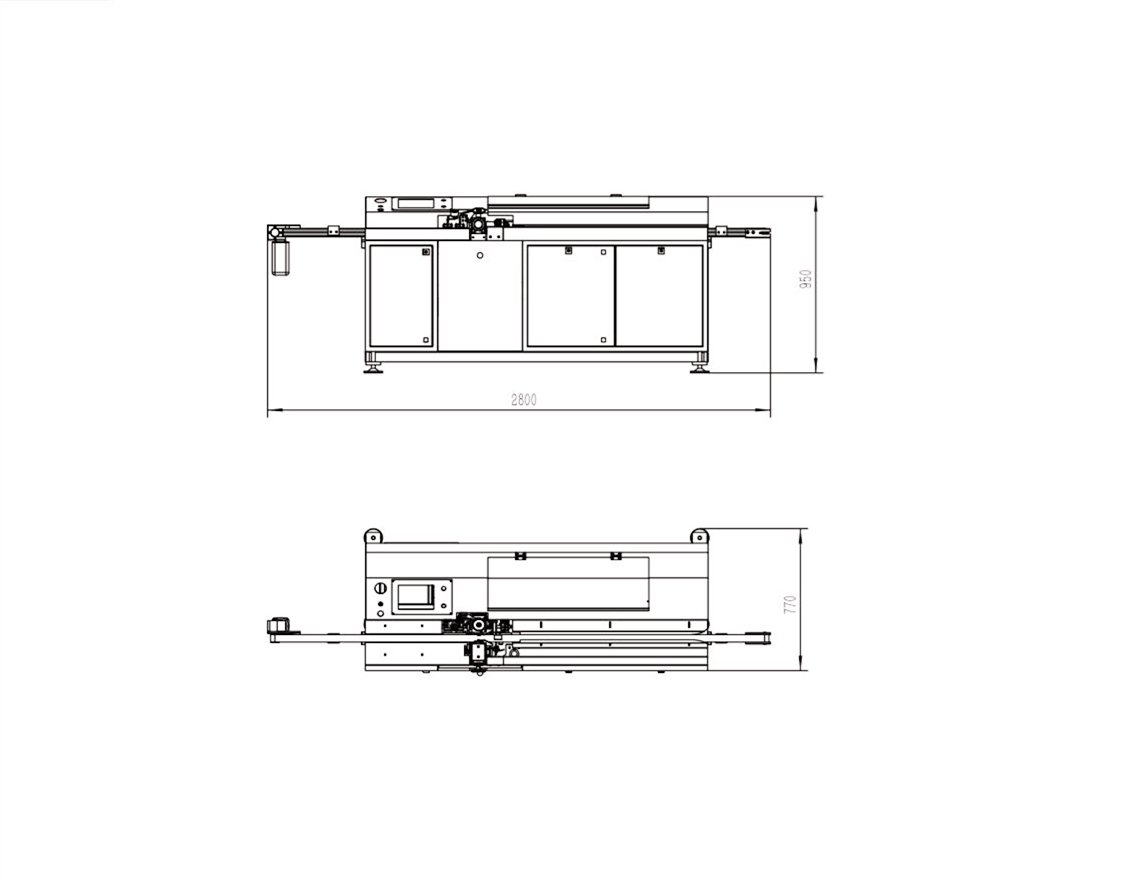 LJTB01 Isolierglas-Butyl-Extruder-Beschichtungsmaschine
LJTB01 Isolierglas-Butyl-Extruder-Beschichtungsmaschine Automatische Isolierglas-Trockenmittel-Füllmaschine
LIJIANG Glas - Typ: LJGZ2020D / LJGZ2020X / LJGZ2020S
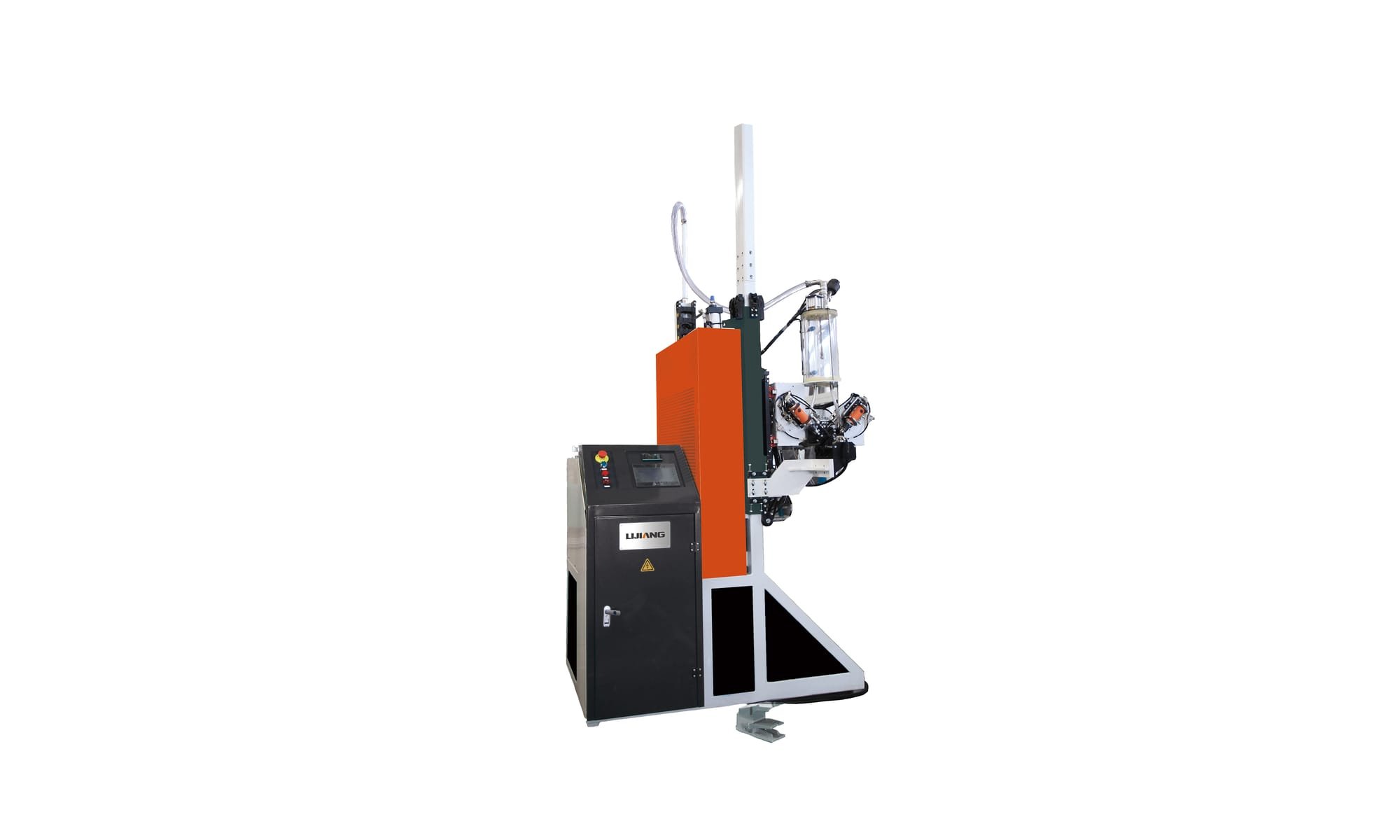
Grundlegendes Arbeitsprinzip
- Nimmt das SPS-Kontrollsystem Deutschland Siemens, stabile Leistung an;
- Automatisches Bohren, Füllen und Versiegeln;
- Die Maschinenhöhe kann entsprechend der Größe des Aluminium-Abstandshalters oder des Edelstahl-Abstandshalters eingestellt werden;
- Molekularsieb automatisch laden und ergänzen;
- Erweitertes Fütterungsgerät, das nach dem Prinzip des Gasflusses konstruiert ist;
- Nimmt industrielle Plastiksprühbehandlung aller Aluminiumrahmen an;
- Kernteile nehmen berühmte importierte Marke an.
Detaillierte Arbeitsschritte
LJGZ2020D Isolierglas-Trockenmittel-Füllmaschine
LJGZ2020X Isolierglas-Trockenmittel-Füllmaschine
LJGZ2020S Isolierglas-Trockenmittel-Füllmaschine
- Sparen Sie mit einem großen Kunststofffass Fütterungszeit und verbessern Sie die Effizienz.
- Schutzvorrichtung für Maschinenkopf
- Füllen geformter Aluminium-Abstandshalter oder Edelstahl-Abstandshalter
- könnte das Molekularsieb mit großen Partikeln füllen, dessen Größe 1,0 bis 1,5 mm beträgt
LJGZ2020X Isolierglas-Trockenmittel-Füllmaschine
- Mit der Führungsschienen-Hebevorrichtung
- Der Kopf ist beim Arbeiten stabil
- Mit großer Abstandshalter-Hilfsfunktion
LJGZ2020S Isolierglas-Trockenmittel-Füllmaschine
- Zwei Tankstellen könnten gleichzeitig arbeiten, um die Arbeitseffizienz zu verbessern;
- Zwei Stationen könnten verschiedene Kombinationen aus normaler Füllung, speziell geformter Füllung und Füllung mit großen Partikeln realisieren. (Optional)
Technische Parameter
| Artikel. | Spez. |
| max. Rahmengröße | 2000mm*2000mm |
| Mindest. Rahmengröße | 300mm*250mm |
| Aluminiumspezifikation | 5,5 ~ 26,5 mm |
| Luftdruck | ≥ 0,65 MPa |
| Stromspannung | Wechselstrom 220 V 50 Hz |
| Leistung | 1Kw |
| Erforderlicher Molekularsiebdurchmesser | 0,5 ~ 0,9 mm (könnte angepasst werden 1,0 ~ 1,5 mm) |
| Abmessungen (L*B*H) | 1400*1200*3600 mm |
| Gewicht | 3000 kg |
Technische Beschreibung
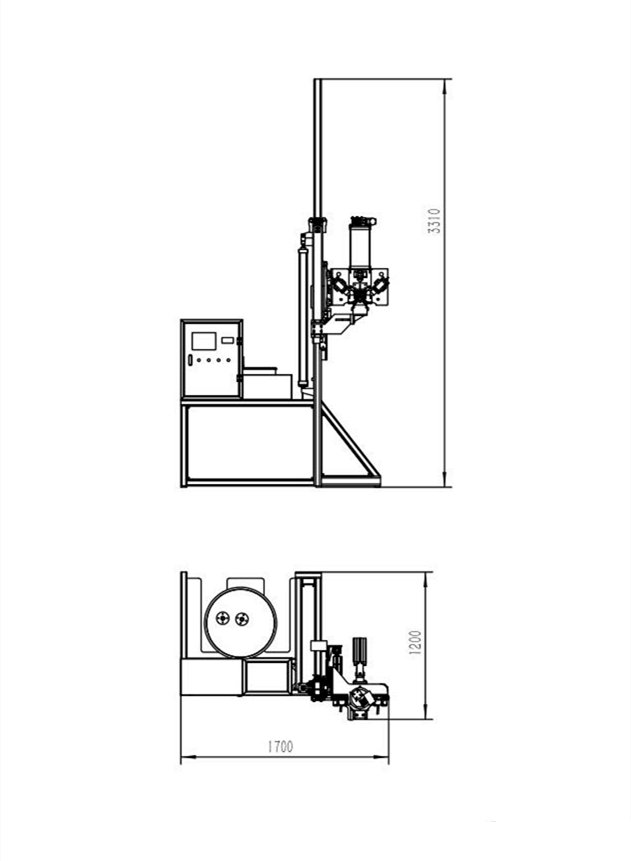 LJGZ2020A Trockenmittel-Füllmaschine für Isolierglas
LJGZ2020A Trockenmittel-Füllmaschine für Isolierglas 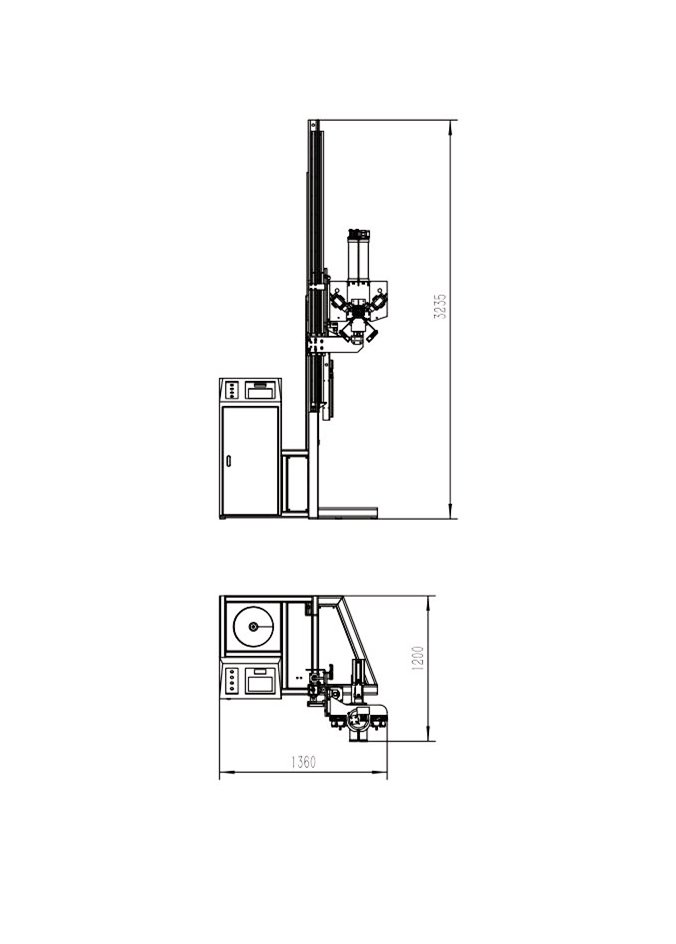 LJGZ2020X Isolierglas-Trockenmittel-Füllmaschine
LJGZ2020X Isolierglas-Trockenmittel-Füllmaschine 